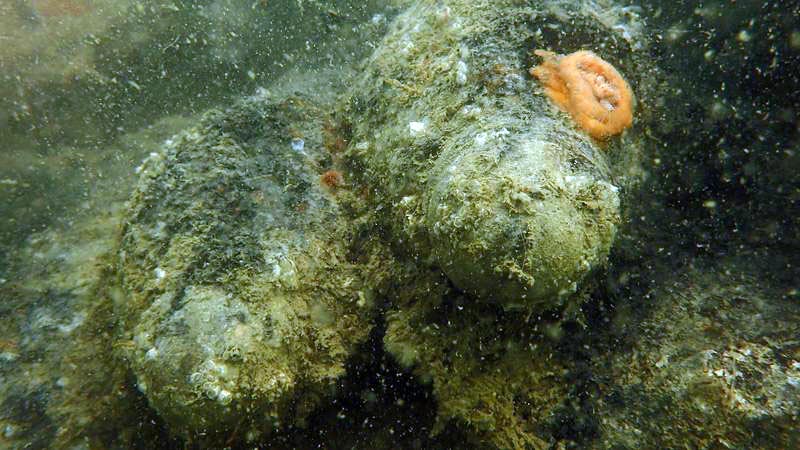
“North Sea Wrecks” – European research project presents results

120 mm shells of a QF-Mk IX naval gun on a wreck off the Belgian coast.
(c) Vlaams Instituut voor de Zee (VLIZ)
What impact do rusting World War II munitions have on the marine environment?
Researchers from the EU project North Sea Wrecks (NSW) dived to World War II wrecks in the North Sea and analyzed samples. In a public symposium on April 19 and 20 at the Alfred Wegener Institute, Helmholtz Centre for Polar and Marine Research (AWI), the EU project led by the German Maritime Museum (DSM) / Leibniz Institute of Maritime History will present results after four and a half years.
How alarming are the ammunition remnants of two world wars that still lie in old wrecks at the bottom of the North Sea and other seas? What are the concrete dangers posed by war wrecks, sunken munitions (UXO) and chemicals such as TNT in the water? The EU-funded, international project “North Sea Wrecks” investigated these questions and examined the extent to which munitions in the sea pose a danger to humans and the environment.
The participating marine research institutes in Belgium, the Netherlands, Germany and Denmark have been on several research expeditions in the North Sea. West of Helgoland, for example, the AWI research vessel Heincke has taken samples from the SMS MAINZ and the SMS Ariadne, which sank there during the First World War. The SMS MAINZ is just one of many wrecks that still contain war equipment, weapons and toxic ammunition residues that could end up in the marine environment. In the German part of the North Sea alone, it is estimated that there are around 1.3 million tons of munitions from which hazardous pollutants could escape through corrosion. “After four and a half years, our project now ends with important results that need to be processed scientifically, politically as well as historically,” says Dr. Sven Bergmann, cultural anthropologist at the DSM and curator of the NSW exhibition.
“Around the wrecks, concentrations of dissolved TNT are sometimes significantly elevated. The chemicals are toxic and carcinogenic, and they are taken up by organisms on site. We are trying to find out what effects this has on the animals,” adds Dr. Matthias Brenner of the Alfred Wegener Institute, who led the expeditions to the German wrecks and is conducting the health studies on the organisms.
The NSW team will present the results to the interested public on Wednesday and Thursday, April 19 and 20, in a symposium at AWI’s facilities. During the two-day event (on site and via videoconference), international experts will explain the working methods, the research results and the risk assessment tools developed in the project. The participating scientists and other experts cordially invite interested parties to join in the conversation about how the future challenges posed by dumped World War II contaminated sites should be dealt with.
“We are delighted that the conclusion of the project and the presentation of the results will take place where it all began: in Bremerhaven. Together with our partner, the Alfred Wegener Institute, we want to give the local population the opportunity to be part of it. At the trade fairs and events we visited with the traveling exhibition developed in the project, there was a lot of interest in the topic every time – whether schoolchildren or senior citizens, people had lots of questions,” says Bergmann.
NSW was funded by the EU’s Interreg North Sea program and worked with nine institutions from five countries to gather more knowledge about the issue. Last year, the NSW team toured the partner countries of Denmark, Belgium, Norway, the Netherlands and Germany with a mobile pop-up traveling exhibition, raising awareness of the issue of World War II legacies among interested people of all generations. There were several stops in this country, and the exhibition is currently on tour at the German Naval Museum in Wilhelmshaven until April 16. In the future, the media stations will move to the new permanent exhibition in the DSM extension, which opens in 2024.
Toxic Legacies of War – North Sea Wrecks Symposium 2023, public online and in-person event, on Wednesday and Thursday, April 19 and 20, both starting at 9 a.m., at the Alfred Wegener Institute, Am Handelshafen 12, in Bremerhaven. Free registration by March 31 and program at: www.dsm.museum/nsw_sympoium2023
North Sea Wrecks is a European interdisciplinary project with a budget of five million euros, funded by the EU through the Interreg program. Involved are eight project partners from five countries in addition to the DSM. The partners involved are: Alfred Wegener Institute, Helmholtz Centre for Polar and Marine Research (Germany); Vlaams Instituut voor de Zee (Belgium); Aarhus University – Department of Geoscience (Denmark); Stichting NHL Stenden Hogeschool – Maritiem Instituut Willem Barentsz (Netherlands); north. io GmbH (Germany); Periplus Consultancy BV (The Netherlands); Forsvarets Forskningsinstitutt (Norway); and Schleswig-Holstein University Hospital – Institute of Toxicology and Pharmacology for Natural Scientists (Germany).
Wissenschaftliche Ansprechpartner:
Dr. Sven Bergmann
Bergmann@dsm.museum
Weitere Informationen:
https://www.dsm.museum/en/press-area/north-sea-wrecks-european-research-project-…














